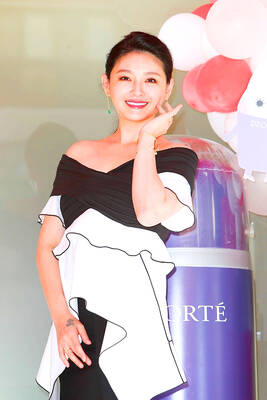The verb “decapitate” combines the Latin words de (off) and caput (head). It means “to cut the head off,” and came into English in the 1610s, by way of the 14th century French word decapiter. The noun form is “decapitation.”
The word “capitation” also exists, although it doesn’t mean to place the head back on the body once it has been removed. It means “the counting of heads” for the purposes of levying a tax, and dates back to the 1610s.
In the early 15th century, the root caput came to be associated with the main, principal, chief or dominant item of its kind. It wasn’t until the 1660s, however, that the word “capital” was first recorded to refer to the main city of a country, being the official seat of government.

Photo: AP 照片:美聯社
The upper case first letter of a sentence came to be called the capital letter — appearing as it does at the “head” of the sentence — in around the 14th century.
The Latin capitulum (chapter) leads to the idea of “to draw up in heads or chapters” and therefore that of arranging terms and conditions in an agreement. In the 1640s this was narrowed down to arranging terms of surrender, giving us the modern verb “to capitulate,” meaning to surrender having negotiated terms, or by extension, to “cease resisting.”
(Paul Cooper, Taipei Times)
動詞「decapitate」結合了拉丁字「de」(脫離、切斷、掉落)和「caput」(頭部),是斷頭的意思。該字源自於十四世紀的法文字「decapiter」,約在一六一○年代進入英語系統,名詞是「decapitation」。
在英語中也有「capitation」這個字,不過並不是把砍斷的頭再接回身體的意思,而是徵稅時按人頭計算之意,該字亦可回朔自一六一○年代。
在十五世紀初,「caput」這個字根開始和主要的、首要的、為首的、支配的這類之概念產生關聯。然而,直到一六六○年代,才有關於「capital」這個字首次用來代表一國首都的記錄,也就是政府的正式所在地。
而句子的第一個字母要大寫,自十四世紀左右起也叫「capital letter」(大寫字母)——顯然是因為它是一個句子的「開頭」。
拉丁字「capitulum」(章節)則引申為起草契約標題或章節、安排協議條款及條件。而到了一六四○年代,其字義便限縮為安排投降條款,因此而有了「capitulate」一字的現代字義︰依協商好的條件投降,並另外衍生出停止反抗的意思。
(台北時報張聖恩譯)

In most cities, food waste is often regarded as one of the most troublesome types of waste: it has a high moisture content, spoils easily and produces strong odors. If not handled properly, it can cause serious sanitation and environmental problems. From the perspective of the circular economy, however, food waste is not “useless leftovers,” but rather an organic resource that has yet to be effectively utilized. The core principle of the circular economy is to break away from the linear model of “production–consumption–disposal,” allowing resources to circulate repeatedly within a system and extending their useful life. Food waste occupies a

In June, headlines shocked the art world when a visitor damaged a 17th-century painting at the Uffizi Galleries in Florence, Italy, while posing for a photograph. This was not an isolated event. Recently, similar disasters have been reported worldwide, from a child damaging a Mark Rothko painting to a tourist breaking an exhibit by pretending to sit on it. Such incidents highlight why museum etiquette is increasingly crucial. First, we must recognize that art and historical objects are fragile. Once damaged, they may never regain their original condition. Many common actions, though harmless at first glance, can have grave consequences. For

A: Google has unveiled its 2025 Year in Search chart. No. 10 to No. 6 are: Typhoon Podul, Chinese drama “Love’s Ambition,” tariffs, US President Donald Trump and singer Khalil Fong’s death. B: Wow, actress Rosy Zhao’s new drama is so popular. So what are the top five? A: No. 5 to No. 1 are: Gemini, hanzii.net, NT$10,000 cash handout, entertainer Big S’ death and earthquakes. B: Hasn’t Trump topped this year’s most-searched people chart? A: Yup, and he’s closely followed by cheerleader GuoGuo Chiang at No. 2, whose husband Zack Fanchiang is also at No. 8. Apparently, people are curious about her extramarital

Continued from yesterday(延續自昨日) The study also uncovered a correlation between breathing patterns and mental well-being. Participants with higher scores on anxiety questionnaires exhibited shorter inhalation periods and more frequent breath pauses during sleep. “We intuitively assume that how depressed or anxious you are changes the way you breathe,” says one researcher involved in the study. “But it might be the other way around.” If this proves true, then training people to adjust their breathing may offer a novel approach to managing conditions like anxiety or depression. 該項研究也揭露了呼吸模式與心理健康之間的關聯。在焦慮問卷得分較高的受試者於睡眠期間表現出的吸氣時間較為短促、呼吸中止更為頻繁。一位參與研究的學者表示:「我們直覺地認為憂鬱或焦慮的程度會改變你的呼吸方式,但有可能是反過來的情況。」如果這一假設得到證實,那麼訓練人們調整呼吸的方式,可能會成為管理焦慮或憂鬱等疾病的新穎方法。 What Did You Learn? 1. What problem did scientists previously face when trying to measure breathing patterns? 2.